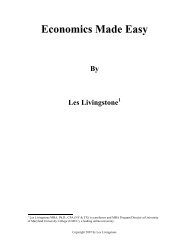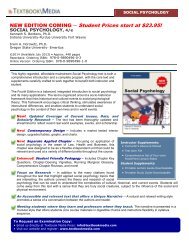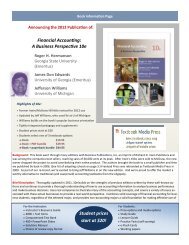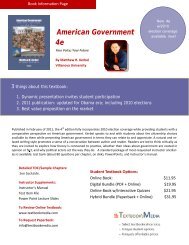Book Information / Sample Chapter(s) (PDF) - Textbook Media
Book Information / Sample Chapter(s) (PDF) - Textbook Media
Book Information / Sample Chapter(s) (PDF) - Textbook Media
Create successful ePaper yourself
Turn your PDF publications into a flip-book with our unique Google optimized e-Paper software.
84 <strong>Chapter</strong> 4 Demand and Supply<br />
create deadweight loss. Removing such barriers so that prices and quantities can adjust<br />
to their equilibrium level will increase the economy’s social surplus.<br />
Demand and Supply as a Social Adjustment<br />
Mechanism<br />
The demand and supply model emphasizes that prices are not set only by demand or<br />
only by supply, but by the interaction between the two. In 1890, the famous economist<br />
Alfred Marshall wrote that asking whether supply or demand determined a price was<br />
like arguing “whether it is the upper or the under blade of a pair of scissors that cuts a<br />
piece of paper.” The answer is that both blades of the demand and supply scissors are<br />
always involved.<br />
The adjustments of equilibrium price and quantity in a market-oriented economy<br />
often occur without much government direction or oversight. If the coffee crop in Brazil<br />
suffers a terrible frost, then the supply curve of coffee shifts to the left and the price of<br />
coffee rises. Some people—call them the coffee addicts—continue to drink coffee and<br />
pay the higher price. Others switch to tea or soft drinks. No government commission is<br />
needed to figure out how to adjust coffee prices; or which companies will be allowed<br />
to process the remaining supply; or which supermarkets in which cities will get how<br />
much coffee to sell; or which consumers will ultimately be allowed to drink the brew.<br />
Such adjustments in response to price changes happen all the time in a market economy,<br />
often so smoothly and rapidly that we barely notice them. Think for a moment of all<br />
the seasonal foods that are available and inexpensive at certain times of the year, like<br />
fresh corn in midsummer, but more expensive at other times of the year. People alter<br />
their diets and restaurants alter their menus in response to these fluctuations in prices<br />
without fuss or fanfare. For both the U.S. economy and the world economy as a whole,<br />
demand and supply is the primary social mechanism for answering the basic questions<br />
about what is produced, how it is produced, and for whom it is produced.<br />
Key Concepts and Summary<br />
1. A demand schedule is a table that shows the quantity demanded at different<br />
prices in the market. A demand curve shows the relationship between quantity<br />
demanded and price in a given market on a graph. The law of demand points out<br />
that a higher price typically leads to a lower quantity demanded.<br />
2. A supply schedule is a table that shows the quantity supplied at different prices<br />
in the market. A supply curve shows the relationship between quantity supplied<br />
and price on a graph. The law of supply points out that a higher price typically<br />
leads to a higher quantity supplied.<br />
3. The equilibrium price and equilibrium quantity occur where the supply and<br />
demand curves cross. The equilibrium occurs where the quantity demanded is<br />
equal to the quantity supplied.<br />
4. If the price is below the equilibrium level, then the quantity demanded will<br />
exceed the quantity supplied. Excess demand or a shortage will exist. If the













